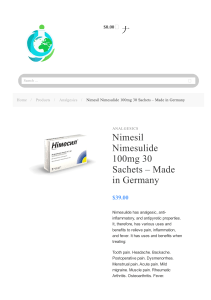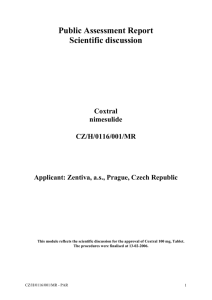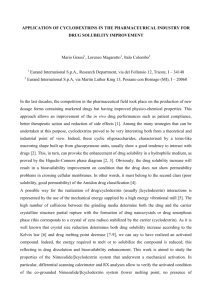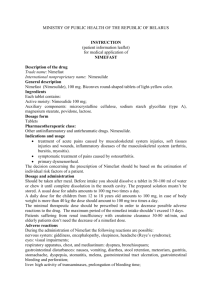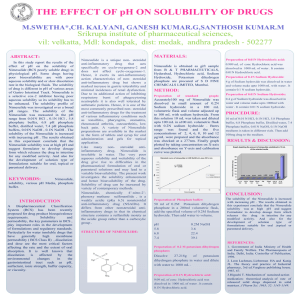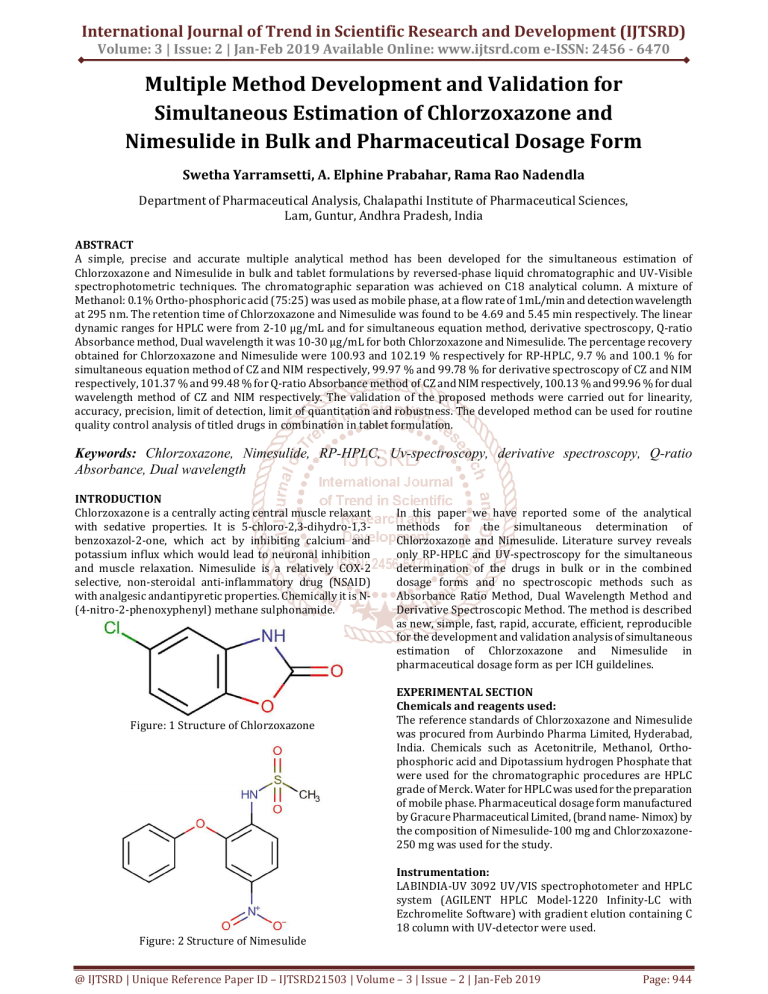
International Journal of Trend in Scientific Research and Development (IJTSRD)
Volume: 3 | Issue: 2 | Jan-Feb 2019 Available Online: www.ijtsrd.com e-ISSN: 2456 - 6470
Multiple Method Development and Validation for
Simultaneous Estimation of Chlorzoxazone and
Nimesulide in Bulk and Pharmaceutical Dosage Form
Swetha Yarramsetti, A. Elphine Prabahar, Rama Rao Nadendla
Department of Pharmaceutical Analysis, Chalapathi Institute of Pharmaceutical Sciences,
Lam, Guntur, Andhra Pradesh, India
ABSTRACT
A simple, precise and accurate multiple analytical method has been developed for the simultaneous estimation of
Chlorzoxazone and Nimesulide in bulk and tablet formulations by reversed-phase liquid chromatographic and UV-Visible
spectrophotometric techniques. The chromatographic separation was achieved on C18 analytical column. A mixture of
Methanol: 0.1% Ortho-phosphoric acid (75:25) was used as mobile phase, at a flow rate of 1mL/min and detection wavelength
at 295 nm. The retention time of Chlorzoxazone and Nimesulide was found to be 4.69 and 5.45 min respectively. The linear
dynamic ranges for HPLC were from 2-10 µg/mL and for simultaneous equation method, derivative spectroscopy, Q-ratio
Absorbance method, Dual wavelength it was 10-30 µg/mL for both Chlorzoxazone and Nimesulide. The percentage recovery
obtained for Chlorzoxazone and Nimesulide were 100.93 and 102.19 % respectively for RP-HPLC, 9.7 % and 100.1 % for
simultaneous equation method of CZ and NIM respectively, 99.97 % and 99.78 % for derivative spectroscopy of CZ and NIM
respectively, 101.37 % and 99.48 % for Q-ratio Absorbance method of CZ and NIM respectively, 100.13 % and 99.96 % for dual
wavelength method of CZ and NIM respectively. The validation of the proposed methods were carried out for linearity,
accuracy, precision, limit of detection, limit of quantitation and robustness. The developed method can be used for routine
quality control analysis of titled drugs in combination in tablet formulation.
Keywords: Chlorzoxazone, Nimesulide, RP-HPLC, Uv-spectroscopy, derivative spectroscopy, Q-ratio
Absorbance, Dual wavelength
INTRODUCTION
Chlorzoxazone is a centrally acting central muscle relaxant
with sedative properties. It is 5-chloro-2,3-dihydro-1,3benzoxazol-2-one, which act by inhibiting calcium and
potassium influx which would lead to neuronal inhibition
and muscle relaxation. Nimesulide is a relatively COX-2
selective, non-steroidal anti-inflammatory drug (NSAID)
with analgesic andantipyretic properties. Chemically it is N(4-nitro-2-phenoxyphenyl) methane sulphonamide.
Figure: 1 Structure of Chlorzoxazone
In this paper we have reported some of the analytical
methods for the simultaneous determination of
Chlorzoxazone and Nimesulide. Literature survey reveals
only RP-HPLC and UV-spectroscopy for the simultaneous
determination of the drugs in bulk or in the combined
dosage forms and no spectroscopic methods such as
Absorbance Ratio Method, Dual Wavelength Method and
Derivative Spectroscopic Method. The method is described
as new, simple, fast, rapid, accurate, efficient, reproducible
for the development and validation analysis of simultaneous
estimation of Chlorzoxazone and Nimesulide in
pharmaceutical dosage form as per ICH guildelines.
EXPERIMENTAL SECTION
Chemicals and reagents used:
The reference standards of Chlorzoxazone and Nimesulide
was procured from Aurbindo Pharma Limited, Hyderabad,
India. Chemicals such as Acetonitrile, Methanol, Orthophosphoric acid and Dipotassium hydrogen Phosphate that
were used for the chromatographic procedures are HPLC
grade of Merck. Water for HPLC was used for the preparation
of mobile phase. Pharmaceutical dosage form manufactured
by Gracure Pharmaceutical Limited, (brand name- Nimox) by
the composition of Nimesulide-100 mg and Chlorzoxazone250 mg was used for the study.
Instrumentation:
LABINDIA-UV 3092 UV/VIS spectrophotometer and HPLC
system (AGILENT HPLC Model-1220 Infinity-LC with
Ezchromelite Software) with gradient elution containing C
18 column with UV-detector were used.
Figure: 2 Structure of Nimesulide
@ IJTSRD | Unique Reference Paper ID – IJTSRD21503 | Volume – 3 | Issue – 2 | Jan-Feb 2019
Page: 944
International Journal of Trend in Scientific Research and Development (IJTSRD) @ www.ijtsrd.com eISSN: 2456-6470
Chromatographic conditions:
The column used for chromatographic separations was C 18
(4.6 i.d., 250 mm length, 5 µm particle size). The analytical
wavelength was set at 295 nm and samples of 20µl was
injected manually. Chromatographic separations were
performed by the mobile phase composition of Methanol :
0.1% Ortho-phosphoric acid (75:25) which is filtered
through 0.22 µm membrane filters and degassed in the
ultrasonic bath. Mobile phase was injected through isocratic
conditions with the flow rate of about 1ml/min.
absorptivity values at particular wavelengths were
submitted in the following equation to obtain the
concentration.
Preparation of standard and sample solutions:
The standard solutions of Chlorzoxazone and Nimesulide
was prepared by dissolving 10mg of drug in 3ml and 10ml of
HPLC grade methanol respectively and the volume was made
upto 10ml with HPLC grade water. Linear dynamic ranges
for HPLC was prepared from 2-10 µg/mL by the standard
solutions.
A1 = absorbance of samples at 280 nm.
Concentration ranges of about 10-30 µg/mL for both
Chlorzoxazone and Nimesulide was prepared with distilled
water and scanned at the UV range against blank solution for
simultaneous equation method, derivative spectroscopy, QRatio Absorbance and Dual wavelength methods.
Cx = (A2ay1-A1ay2)/ (ax2ay1-ax1ay2)
Cy = (A1ax2-A2ax1)/ (ax2ay1-ax1ay2)
Where,
Cx = concentration of CZ
Cy = concentration of NIM
A2 = absorbance of samples at 390 nm.
ax1 is the absorptivity of CZ at 280 nm.
ax2 is the absorptivity of CZ at 390 nm.
ay1 is the absorptivity of NIM at 280 nm.
ay2 is the absorptivity of NIM at 390 nm.
For the sample preparation 10 tablets were taken pulverized
and weight equivalent to 10mg was taken and dissolved in
10ml of HPLC grade methanol. The solution was further
diluted with HPLC grade water to get the concentration of
8µg/ml.
RESULTS AND DISCUSSION
FOR HPLC:
The standard solutions of both Chlorzoxazone and
Nimesulide were scanned in the UV range of 200-400 nm
against the blank solution and the wavelength of 295 nm was
found to show appreciable absorbance for both the drugs.
Figure 4: Spectrum of Chlorzoxazone at 280 nm.
Many trails were performed by the change of different
columns, mobile phase and their ratios out of which a
suitable method was developed by the C18 column, mobile
phase of Methanol: 0.1% Ortho-phosphoric acid (75:25),
with the flow rate of about 1 ml/min and the run time of
7min. Peaks were eluted and showed better resolution,
theoretical plate count and asymmetry was found at 4.69
and 5.45 min respectively for Chlorzoxazone and
Nimesulide. The chromatogram of both the drugs was shown
in the Figure 3.
Figure 5: Spectrum of Nimesulide at 390 nm.
Figure 3: Chromatogram of Chlorzoxazone and
Nimesulide.
FOR SIMULTANEOUS EQUATION METHOD:
The standard solutions of both Chlorzoxazone and
Nimesulide were scanned in the UV range and the
wavelength was found to be 280 nm and 390 nm
respectively. Calibration curves were plotted for both the
drugs with the concentration range of 10-30 µg/mL.
Absorption spectrum for both the drugs was shown in the
Figure 4 and Figure 5 respectively. The absorbance and
FOR SPECTROPHOTOMETRIC FIRST DERIVATIVE ZEROCROSSING METHOD:
Working standard stock solutions were scanned in the UV
range (215-400 nm), the absorption spectra thus obtained
were derivatized to first order and from the overlain spectra
of both drugs wavelengths were selected.
First order derivative spectra was determined for both drugs
as shown in the Figure 6-7. zero crossing point was at 244
nm and 388 nm for Chlorzoxazone and nimesulide
respectively.From the overlain spectra of both the drugs
wavelengths selected for quantization were 388nm for CZ
(Zero crossing point of NIM) and 244 nm for NIM (Zero
crossing point of CZ). The calibration curves for CZ and NIM
was plotted in the concentration range of 10-30µg/ml at
wavelengths of 244 nm and 388 nm respectively.
@ IJTSRD | Unique Reference Paper ID – IJTSRD21503 | Volume – 3 | Issue – 2 | Jan-Feb 2019
Page: 945
International Journal of Trend in Scientific Research and Development (IJTSRD) @ www.ijtsrd.com eISSN: 2456-6470
of CZ where NIM shows the same absorbance at this
wavelength. Similarly, wavelengths 386nm and 398nm were
selected as λ1 and λ2 for estimation
of NIM where CZ shows the same absorbance at these
wavelengths. Overlain spectrum for dual wavelength method
was shown in the Figure 9.
Figure 6: first order derivative overlain spectra of
Chlorzoxazone at 244 nm.
Figure 9: Spectrum of Dual wavelength method
Figure 7: first order derivative overlain spectra of
Nimesulide at 388 nm.
FOR Q-RATIO ABSORBANCE METHOD:
From the overlain spectrum of both the drugs isoabsorptive
point for the drugs was found to be 268 nm.The
concentration of two drugs in the mixture was calculated by
using following equations.
CX = (QM – QY)*A1 / (QX – QY)* aX1
CY = A1/ aX1 - CX
Where A1 and A2 are absorbance’s of the mixture at 280nm
and 390nm respectively; aX1 and aY1 are absorptivites of CZ
and NIM respectively at 280nm and aX2 and aY2 are
absorptivites of CZ and NIM respectively at 390nm.
QM = A2/A1, QX = AX2/AX1 and QY = AY2/AY1.
Overlain spectrum of the drugs was shown in the Figure 8.
Figure 8: Overlain spectra of CZ and NIM showing IsoAbsorptive point at 268nm
FOR DUAL WAVELENGTH METHOD:
10µg/ml concentration of both the drugs were scanned in
the UV range and from the overlain spectra of both the drugs
279nm and 289nm was selected as λ1 and λ2 for estimation
METHOD VALIDATION:
LINEARITY:
The Linearity of analytical method is its ability to obtain test
results, which are directly proportional to the concentration
of analyte in the test sample. It is evaluated by analyzing a
series of different concentrations ranging between 2-10
µg/ml and 10-30 µg/ml of both CZ and NIM for HPLC and
other methods respectively. Calibration graphs were plotted
and linear relationship was established.
PRECISION:
The precision of the analytical method was studied by
analysis of multiple sampling of homogenous sample,
expressed as %RSD. Method Reproducibility was
demonstrated by repeatability and intermediate precision
measurements. The repeatability (within in the day) and
intermediate precision (for 3 days) was carried for each
compound. The obtained results within and between days
trails are in acceptable range indicating good precision of the
proposed method.
ACCURACY:
The accuracy of an analytical method is the closeness of test
results obtained by that method compared with the true
values. To confirm the accuracy of the proposed method,
recovery experiments were carried out by standard addition
technique. The accuracy of the method was carried out by
adding by known amounts of each drug corresponding to
three concentration levels, 80, 100 and 120% of the label
claim along with the excipients in triplicate. The samples
were given the same treatment as described in sample
preparation. The percentage recoveries of CZ and NIM at
each level and each replicate were determined. The mean of
percentage recoveries (n=3) and the relative standard
deviation was calculated. It was confirmed from results that
the method is highly accurate.
LIMIT OF DETECTION AND LIMIT OF QUANTIFICATION:
Calibration curve was repeated for 5 times and the standard
deviation (SD) of the intercepts was calculated for UV and
Chromatogram signals obtained with known low
concentrations of analytes was compared with the signals of
blank samples, a signal- to- noise ratio 3:1 and 10:1 is
considered for calculating LOD and LOQ respectively for
HPLC.
@ IJTSRD | Unique Reference Paper ID – IJTSRD21503 | Volume – 3 | Issue – 2 | Jan-Feb 2019
Page: 946
International Journal of Trend in Scientific Research and Development (IJTSRD) @ www.ijtsrd.com eISSN: 2456-6470
ROBUSTNESS:
The robustness of the method was determined by making
slight changes in the chromatographic conditions. The
robustness of the proposed HPLC method was assessed for
peak resolution and symmetric factor. The parameters
investigated are Apparent pH of the mobile phase, Mobile
phase organic content, Mobile phase flow rate, Detection
wave length.
SYSTEM SUITABILITY:
System precision was determined on six replicate injections
of standard preparation all important characteristics
including %RSD, resolution (between CZ and NIM), tailing
factor and theoretical plate number were measured.
ASSAY OF TABLETS:
Applicability of the method was tested by analyzing the
commercially available formulations containing the binary
mixture of CZ and NIM. The values of % recovery from
formulations are found to be very close to each other as well
as to the label value of commercial pharmaceutical
formulation.
Results for the validation parameters for all the methods are
shown in Tables
Table 1:Simultaneous estimation of Chlorzoxazone and
Nimesulide by HPLC
Parameters
Chlorzoxazone Nimesulide
Linearity
2-10µg/mL
2-10µg/mL
Equation Y=mx
Y = 1E+06x
Y = 229436x
Correlation coefficient
0.9914
0.9948
LOD (µg/mL)
0.633
0.304
LOQ (µg/mL)
1.90
0.912
Precision Intraday
0.346
1.66
Precision Interday
0.403
1.93
Theoretical plates
9880
10773
Asymmetry
0.99
1.02
Retention time
5.467
4.720
% Recovery
Amount found in
formulation(mg)
100.93
102.19
249.5
102.09
Table 2: Simultaneous estimation of Chlorzoxazone and
Nimesulide using simultaneous equation method
Chlorzoxazone Nimesulide
Parameters
(280 nm)
(390 nm)
Linearity
10-30µg/mL
10-30µg/mL
Equation (y=mx)
y = 0.025x
y = 0.024x
Correlation coefficient
0.996
0.998
LOD (µg/mL)
3.33
3.57
LOQ (µg/mL)
10
10.71
Precision Intraday
0.561
0.389
Precision Interday
0.524
0.457
% Recovery
Amount found in
formulation(mg)
99.7
100.01
248.89
99.23
Table 3: Spectrophotometric first derivative Zerocrossing method for simultaneous estimation of
Chlorzoxazone and Nimesulide
Chlorzoxazone Nimesulide
Parameters
(244 nm)
(388 nm)
Linearity
10-30µg/mL
10-30µg/mL
Equation (y=mx)
y = 0.026x
y = 0.0207x
Correlation coefficient
0.993
0.9913
LOD (µg/mL)
3.95
3.66
LOQ (µg/mL)
10.94
9.98
Precision Intraday
0.4315
0.441
Precision Interday
0.430
0.853
% Recovery
Amount found in
formulation(mg)
99.97
99.78
250.14
99.89
Table 4: Q-Absorbance Ratio method for the simultaneous
estimation of Chlorzoxazone and Nimesulide
Chlorzoxazone Nimesulide
Parameters
(268 nm)
(268 nm)
Linearity
10-30µg/mL
10-30µg/mL
Equation (y=mx)
y = 0.0298x
y = 0.0029x
Correlation coefficient
0.992
0.997
LOD (µg/mL)
3.75
3.66
LOQ (µg/mL)
10.25
9.98
Precision Intraday
0.361
1.67
Precision Interday
0.540
1.745
% Recovery
Amount found in
formulation(mg)
101.37
99.48
250.15
99.85
Table 5: Dual wavelength method for simultaneous
estimation of Chlorzoxazone and Nimesulide
Parameters
Chlorzoxazone Nimesulide
10-30
Linearity
10-30µg/mL
µg/mL
Equation (y=mx)
y = 0.0003x
y = 0.0028x
Correlation coefficient
0.9924
0.997
LOD (µg/mL)
3.41
3.63
LOQ (µg/mL)
10.23
9.89
Precision Intraday
1.96
1.696
Precision Interday
1.258
1.66
% Recovery
Amount found in
formulation (mg)
100.13
99.96
248.98
99.63
CONCLUSION
All the proposed spectrophotometric and chromatographic
methods were found to be simple, sensitive, accurate and
precise for the determination of Chlorzoxazone and
Nimesulide in the pharmaceutical dosage form. The methods
utilizes easily available and less economical solvent for
analysis of Chlorzoxazone and Nimesulide hence the
methods were economical for the estimation of
Chlorzoxazone and Nimesulide in synthetic mixture.
@ IJTSRD | Unique Reference Paper ID – IJTSRD21503 | Volume – 3 | Issue – 2 | Jan-Feb 2019
Page: 947
International Journal of Trend in Scientific Research and Development (IJTSRD) @ www.ijtsrd.com eISSN: 2456-6470
REFERENCES
[1] Snehal J. More, Suparna S. Tandulwadkar, Ajinkya
R.Nikam, AtulS.Rathore, L.Sathiyanarayanan, and
Kakasaheb R.Mahadik (2012). Application of HPLC for
the Simultaneous Determination of Paracetamol,
Chlorzoxazone, and Nimesulide in Pharmaceutical
Dosage Form. ISRN Chromatography Volume 2012,
Article ID: 252895, P1-8.
[2] S. Ravisankar, M. Vasudevan, M. Gandhimathi, B.Suresh.
(1998). Reversed-phase HPLC method for the
estimation of acetaminophen, ibuprofen and
chlorzoxazone in formulations. Elsevier, 46(6), P 15771581.
[3] Vinod Maheshwari, Jaydeep Sangani, Naimish Kariya,
Payal Maheshwari, Jenisha Roka. Development And
Validation Of Rp-Hplc Method For Simultaneous
Estimation Of Diclofenac Sodium And Chlorzoxazone In
Their Combined Tablet Dosage Form. Inventi:
ppaqa/1049/13.
[4] Jigar Patel, Pinak Patel (2014). Rp-Hplc Method
Development And Validation For The Estimation Of
Diclofenac Sodium, Tramadol Hydrochloride And
Chlorzoxazone From Their Combined Tablet Dosage
Form. International Journal of Pharmacy and
Pharmaceutical Sciences. 6(7), P632-637.
[5] Shaikh K, Devkhile A (2008). Simultaneous
determination of aceclofenac, paracetamol, and
chlorzoxazone by RP-HPLC in pharmaceutical dosage
form. J Chromatogr Sci. 46(7), P649-52.
[6] Nitin D. Rawool*, A. Venkatchalam (2013).
Development and validation of a rapid HPLC method
for the simultaneous estimation of nimesulide and
tizanidine hydrochloride in pharmaceutical tablet
dosage form. ACAIJ, 12(11), P408-414.
[7] British Pharmacopoeia 2007, Volume I & II, Accessed
soft copy.
[8] Indian Pharmacopoeia 2007, Volume II,Published by
the controller of Publication, Ministry of Health and
Family welfare, New Delhi 681.
[9] Yousry M. Issa, Sayed I.M. Zayed, Ibrahim H.I. Habib
(2010). Simultaneous determination of ibuprofen and
paracetamol using derivatives of the ratio spectra
method. Arabian Journal of Chemistry. 4, P259-263.
[10] Dr. A. Rajasekaran (2010). Hand book of ultra-visible
& infrared spectroscopy. Tamil Nadu: Rupi publication.
P76-83.
@ IJTSRD | Unique Reference Paper ID – IJTSRD21503 | Volume – 3 | Issue – 2 | Jan-Feb 2019
Page: 948

